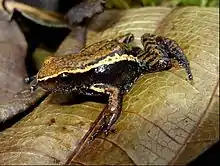Hyloxalus
Hyloxalus is a genus of poison dart frogs.[1][2][3][4] The genus is distributed in Central and South America, from Panama south to Peru (along the Pacific coast), along with Venezuela, Colombia, and Ecuador. They also inhabit the eastern foothills of the Andes in Bolivia to Venezuela, east to the upper Amazon Basin. Many Hyloxalus species, such as the cream-back, bear superficial resemblances to hylids, such as the presence of small webs between their toes, and the discs at the end of their toes are slightly adhesive. This may be one of the oldest of dendrobatid genera; if this is the case, the genus has changed little since it first evolved.
| Hyloxalus | |
|---|---|
 | |
| Cream-backed poison frog (H.subpunctatus) | |
| Scientific classification | |
| Kingdom: | Animalia |
| Phylum: | Chordata |
| Class: | Amphibia |
| Order: | Anura |
| Family: | Dendrobatidae |
| Subfamily: | Hyloxalinae |
| Genus: | Hyloxalus Jiménez de la Espada, 1870 |
| Diversity | |
| 59 species (see text) | |
| Synonyms | |
|
Phyllodromus Jiménez de la Espada, 1875 | |
Species
There are around 60 species:[3]
- Hyloxalus abditaurantius (Silverstone, 1975)
- Hyloxalus aeruginosus (Duellman, 2004)
- Hyloxalus anthracinus (Edwards, 1971)
- Hyloxalus awa (Coloma, 1995)
- Hyloxalus azureiventris (Kneller and Henle, 1985) Sky-blue poison frog
- Hyloxalus betancuri (Rivero and Serna, 1991)
- Hyloxalus bocagei Jiménez de la Espada, 1870
- Hyloxalus borjai (Rivero and Serna, 2000)
- Hyloxalus breviquartus (Rivero and Serna, 1986)
- Hyloxalus cevallosi (Rivero, 1991)
- Hyloxalus chlorocraspedus (Caldwell, 2005)
- Hyloxalus chocoensis Boulenger, 1912
- Hyloxalus craspedoceps (Duellman, 2004)
- Hyloxalus delatorreae (Coloma, 1995)
- Hyloxalus edwardsi (Lynch, 1982)
- Hyloxalus elachyhistus (Edwards, 1971)
- Hyloxalus eleutherodactylus (Duellman, 2004)
- Hyloxalus exasperatus (Duellman and Lynch, 1988)
- Hyloxalus excisus (Rivero and Serna, 2000)
- Hyloxalus faciopunctulatus (Rivero, 1991)
- Hyloxalus fallax (Rivero, 1991)
- Hyloxalus fascianigrus (Grant and Castro-Herrera, 1998)
- Hyloxalus felixcoperari Acosta-Galvis and Vargas Ramírez, 2018
- Hyloxalus fuliginosus Jiménez de la Espada, 1870
- Hyloxalus idiomelus (Rivero, 1991)
- Hyloxalus infraguttatus (Boulenger, 1898)
- Hyloxalus insulatus (Duellman, 2004)
- Hyloxalus italoi Páez-Vacas, Coloma, and Santos, 2010
- Hyloxalus lehmanni (Silverstone, 1971)
- Hyloxalus leucophaeus (Duellman, 2004)
- Hyloxalus littoralis (Péfaur, 1984)
- Hyloxalus maculosus (Rivero, 1991)
- Hyloxalus maquipucuna (Coloma, 1995)
- Hyloxalus marmoreoventris (Rivero, 1991)
- Hyloxalus mittermeieri (Rivero, 1991)
- Hyloxalus mystax (Duellman and Simmons, 1988)
- Hyloxalus nexipus (Frost, 1986)
- Hyloxalus parcus (Rivero, 1991)
- Hyloxalus patitae (Lötters, Morales, and Proy, 2003)
- Hyloxalus peculiaris (Rivero, 1991)
- Hyloxalus peruvianus (Melin, 1941)
- Hyloxalus pinguis (Rivero and Granados-Díaz, 1990)
- Hyloxalus pulchellus (Jiménez de la Espada, 1875)
- Hyloxalus pulcherrimus (Duellman, 2004)
- Hyloxalus pumilus (Rivero, 1991)
- Hyloxalus ramosi (Silverstone, 1971)
- Hyloxalus ruizi (Lynch, 1982)
- Hyloxalus saltuarius (Grant and Ardila-Robayo, 2002)
- Hyloxalus sanctamariensis Acosta-Galvis and Pinzón, 2018
- Hyloxalus sauli (Edwards, 1974)
- Hyloxalus shuar (Duellman and Simmons, 1988)
- Hyloxalus sordidatus (Duellman, 2004)
- Hyloxalus spilotogaster (Duellman, 2004)
- Hyloxalus subpunctatus (Cope, 1899) Cream-backed poison frog
- Hyloxalus sylvaticus (Barbour and Noble, 1920)
- Hyloxalus toachi (Coloma, 1995)
- Hyloxalus utcubambensis (Morales, 1994)
- Hyloxalus vergeli Hellmich, 1940
- Hyloxalus vertebralis (Boulenger, 1899)
- Hyloxalus whymperi (Boulenger, 1882)
- Hyloxalus yasuni Páez-Vacas, Coloma, and Santos, 2010
References
- Emmet Reid Dunn. 1957. Neotropical frog genera: Prostherapis versus Hyloxalus, with remarks on Phyllobates. Copeia. 1957(2) :77-78.
- http://digitallibrary.amnh.org/dspace/bitstream/2246/5803/1/B299.pdf
- Frost, Darrel R. (2015). "Hyloxalus Jiménez de la Espada, 1870". Amphibian Species of the World: an Online Reference. Version 6.0. American Museum of Natural History. Retrieved 11 April 2015.
- "BioLib - Hyloxalus". Biolib.cz. Retrieved 2011-11-24.
| Wikispecies has information related to Hyloxalus. |